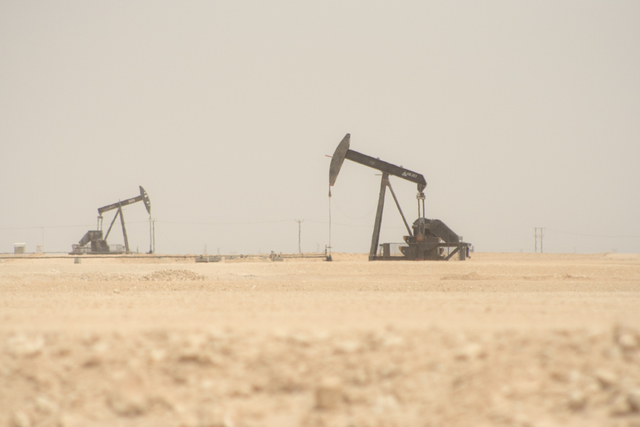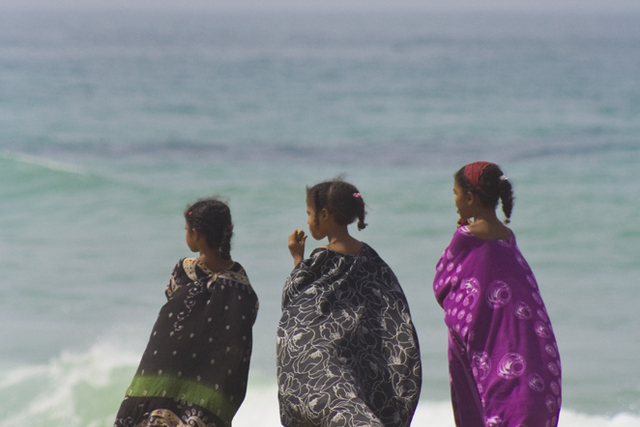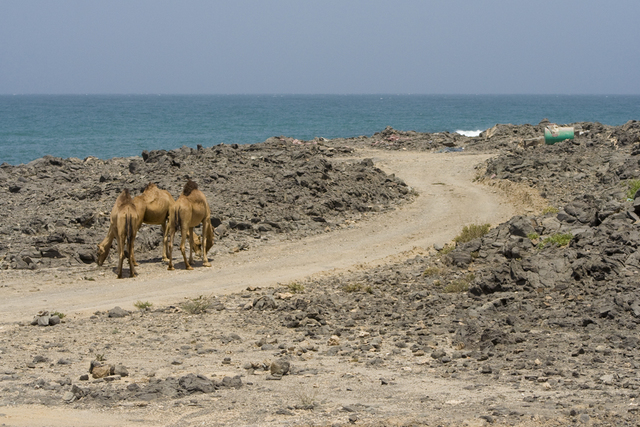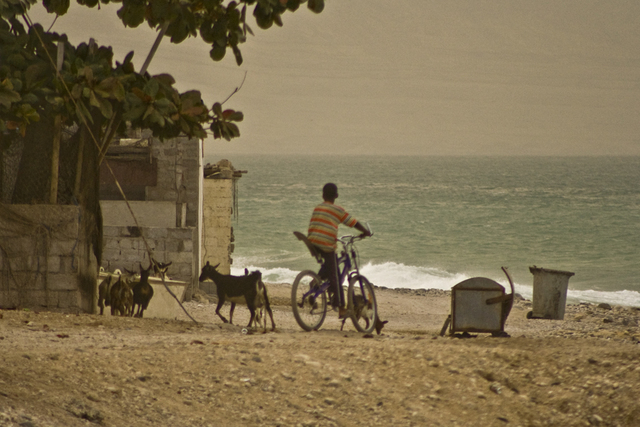
By Andrew S. Lewis
On a searing afternoon in June 2010, I sat with a team of professional surfers in a conference room inside the opulent Grand Hyatt Muscat. We had been invited by Oman’s Ministry of Tourism, which had gathered a junket of local journalists to hear us announce that we had discovered “world-class” waves along Oman’s seven-hundred-mile Arabian Sea coast, and that the sultanate could be the next great surfing destination. In an adjacent room, there was another conference being held by British Petroleum—the placard by the door read “Explorative Strategies.” To me, there seemed little difference between their mission and ours. Waves, oil—in Oman, they both meant money.
Sitting next to me was the Spanish professional surfer Pablo Gutiérrez, who had recently attracted attention for an expedition he had joined in Libya, where he had discovered outside Tripoli the longest wave ever surfed in the Mediterranean. Gutiérrez was a veteran traveler and a willing explorer like the rest of those in our group, but even he was reticent about disclosing the location of what we’d found. The other surfers—a crack team made up of pros from Australia, France and the United States—were unsure, too. “What can we say?” Gutiérrez said.

Our guide, a British expat named Gardner, rolled his eyes. He had come to Oman in the 1990s to work as a desalination engineer and had fallen in love with the sultanate’s wild beauty—the Rub’ al Khali desert and its colossal, shifting dunes; the Norwegian-like fjords in the northern governorate of Musandam; the biologically diverse coastal foothills and plains. He had since become one of Oman’s few outdoor guides, and for the past two weeks had led our team across hundreds of miles of desolate beaches, from the monsoon-drenched southern city of Salalah to Muscat, in the arid north. Along the way, he had put us on what I knew was one of the best waves on the Arabian Peninsula. “Look,” Gardner said as the journalists settled down across the table. “Let’s not forget what we’re here for.”
In the last two decades, Oman has been gradually coming to terms with its draining oil fields. Though petroleum continues to account for about three-quarters of the sultanate’s revenue, Oman has some of the smallest proven reserves in the region, producing about a million barrels a day—two million fewer than neighboring United Arab Emirates, a drastically smaller country. Although technological innovations and aggressive exploration have helped boost output in recent years, most estimates continue to indicate a peak in crude oil production by 2017, and a decline in total hydrocarbon production after 2020. Aware that his country will soon be unable to be sustained by petrodollars, Oman’s well-regarded leader, Sultan Qaboos bin Sa’id al Sa’id, has been searching for new, progressive sources of income—namely tourism.
But in Oman, tourism is a new concept.
Entertaining international visitors is no big deal in neighboring UAE, where globalization has been embraced for decades and a booming tourist trade has firmly entrenched itself both economically and culturally. But in Oman, tourism is a new concept. Not long ago, the sultanate was virtually closed off to the outside world, thanks to Qaboos’s father, Sultan Sa’id bin Taimur.

A reclusive despot whose reign lasted from 1932 to 1970, Sa’id repressed Omanis by way of isolation. Under his rule, Oman built not a single commercial airport and had only three land routes, all of them left over from ancient times. The oldest route followed the eighth century B.C. frankincense trail that ran from Dhofar Governorate, in Oman’s lush south, down to the ancient Himyarite city of Muza, on Yemen’s Red Sea coast. The other two were trade routes that ran across the north—one from Dubai to Muscat, along the Gulf of Oman, and the other snaking from the oasis town of Buraimi over the Hajar Mountains and into the UAE.
Other than the Bedouins, who had been wandering the Arabian Desert for centuries, Omanis were forbidden from moving. A young man could not leave his village to seek work elsewhere in the country without the permission of the Sultan. Nor could a father repair the roof of his home without Sa’id’s personal okay. While the majority of the Arab world was entertaining the first Western oilmen and tourists in the 1960s, Sa’id kept Oman shut and retreated to the confines of his palace in Salalah, where he barked orders to various government officials exclusively by radiotelephone.

Sa’id’s son, Qaboos, who had been sent to school in England, returned home with a respect for Western education and love of classical music. He quickly deposed his father in a bloodless coup on July 23, 1970, sending him into exile in England, where he died two years later. In the three decades since, Qaboos has worked to modernize Oman without compromising its cultural heritage. Today, the sultanate is a bastion of calm in a region plagued by chaos. Qaboos has rather miraculously managed to conduct concurrent and happy relations with the West and his Middle Eastern neighbors. He even maintains a healthy commercial trade with Israel, while quietly accommodating a robust material goods smuggling operation with US sanctions-starved Iran. It was Qaboos himself who first facilitated the most recent nuclear negotiations between the U.S. and Iran, which led to the historic July 2015 accord.
In a region on edge due in part to youth uprisings following the Arab Spring, Qaboos is widely supported by young Omanis for his investment in universities and commitment to cultural tolerance. And yet, for the astonishing growth and peace Qaboos has been able to achieve in such a short time, the world has taken little notice.
But I had been watching Oman for years. As a journalist covering surfing, I had made it my job to scour remote coasts for new, previously unridden waves, and had long suspected that Oman’s vast shoreline held liquid riches. Because it tilts diagonally against thousands of miles of open Arabian Sea and Indian Ocean, the Omani coast has been made saw-toothed by headlands shaped by thousands of years of lashing cyclones and strong currents. To surfers, unexplored headlands like Oman’s induce the same thrill that petroleum fields do in oilmen, for tucked inside these knuckles of land might exist “pointbreaks”—waves that peel uniformly for great distances, creating liquid walls upon which to glide.

The problem is that today—in a world inhabited by some thirty five million surfers—there are few pointbreaks left that haven’t been “discovered.” In the 1970s, surfers stumbled upon the long waves of Bali’s Bukit Peninsula, spawning a new generation of explorers willing to go deep into the world in search of new, even better waves.
These days, most of Indonesia has been tapped, as well as the South Pacific, the Americas and Europe. The mark left by the surf tourism trade has not always been the one of purity that is often associated with the act of wave riding. Bali, for example, has become Cancunified—that is, overrun with drunk and drugged tourists. Bali’s beaches and seaside cliffs reek of the raw sewage draining from the exposed pipes of resorts, hotels and guesthouses—built hastily to meet the island’s surging numbers of tourists—without concern for the fragile reef ecosystems just offshore where the pollution often settles. On the North Shore of Oahu, Hawaii—the “birthplace of surfing”—the hordes are so intense that a kind of war between locals and foreign surfers has been raging for decades. In the winter months, when the surf is best, fights over waves are commonplace, almost perfunctory.
The more I traveled the world, surfing in places like Bali and Hawaii—and in places yet to be altered by tourism—I became haunted by my own role in twenty first century travel. It is easy to separate modern tourism from the Age of Exploration and the subsequent days of colonialism, if only because of the years and cultural knowledge that stands between them and us. But it is false to believe that what we are doing, and the impact of our doing, is not similar—or perhaps even the same thing. In the late nineteenth century, Robert Luis Stevenson visited the Kiribati island of Butaritari, in the South Pacific, and observed the ravages of drink and disease and cultural imposition foisted upon the islanders by their new European neighbors. “Ten years more,” RLS noted in his journal, “and the old society will have entirely vanished.”
When we had arrived in Oman, Gardner first led us south from Muscat through the desolate Rub’ al Khali and toward the Dhofar coast. Outside Salalah, camels replaced vehicles on a thread of pavement that corkscrewed along ancient riverbeds slicing through the Qara Mountains. On the other side we found a dazzlingly turquoise Arabian Sea, torn into millions of whitecaps by the damp, relentless wind of the khareef, the annual monsoon.
Before us was a pointbreak, its long, wind-groomed walls peeling for hundreds of yards. It wasn’t perfect. Waves never are. But it was empty, untouched.
As we wound back north, the shoreline thrust outward into just the kind of headland we had been hoping to find. Gradually, the coast curved back into itself and the wind clocked offshore. In the distance ran plums of mist, like a locomotive’s smoke tracing the horizon. We edged off the road to the water’s edge. Before us was a pointbreak, its long, wind-groomed walls peeling for hundreds of yards. It wasn’t perfect. Waves never are. But it was empty, untouched.

After watching Gutiérrez and the other surfers for a few minutes, I paddled out to join them. To ride a wave that has never been surfed before is disembodying. The popping to your feet is familiar, but the ride is full of nuance that cannot be felt on any other wave on Earth—the way the wave speeds up over shallow sections of bottom, the way is slows down over deep; the way it bends along the point; the grain on its face changing at the slightest shift in the direction of the wind, vibrating beneath your feet.
When my first wave was finished, I slipped off its back and fell from my surfboard and into the water. A gust of wind tore from a distant valley. I floated for a while, looking up and down the coast. This wasn’t the greatest discovery ever, but I knew the wave was good enough to attract more surfers. I tried to imagine what these barren shores would look like with hundreds of tourists, and beach cabanas, and local kids selling Coke and renting umbrellas for extortionate prices, and a high-rise hotel and golf course tucked up in that distant valley. Discos and prostitutes and drugs.

This was when the weight of our discovery settled in. This was when I wished I weren’t here for the explicit purpose of determining the feasibility of surf tourism in Oman. What would I think when I returned ten years later to find the children from the nearby town making mojitos for the Western women in white bikinis and Western men in Speedos who had come to be pampered and fry like bacon?
So the race was on for the riches of the Arabian Sea—its finite oil and its infinite waves.
We spent another week driving north along the coast, sometimes on smooth stretches of highway, other times across beaches where the only sign of civilization were abandoned Bedouin camps drifted over by sand. There were waves everywhere, all of them worth riding, all of them empty. One day, we turned inland through the flattest stretch of land I had ever seen in my life: Block 6, one of Oman’s most productive oilfields. And yet. “You see,” Gardner said, pointing to the hundreds of still derricks, their entomic pump-heads frozen at the point when their wells went dry. “There’s more oil, but it’s offshore, and it’s hard to get.”
So the race was on for the riches of the Arabian Sea—its finite oil and its infinite waves.
In 1996 Oman launched Vision 2020, an economic diversification strategy and plan in which tourism became a top priority. Along with investment in manufacturing and services sectors, the hope was that there would be a net increase in the sultanate’s non-oil GDP from about sixty percent to eighty percent by 2020. But when our team arrived in 2010, non-oil GDP had actually slipped backward, to fifty-three percent. Although there were now over seven thousand miles of paved road webbing the sultanate and an inflow of nearly two million tourists—and one billion dollars in revenues—annually, the tourism sector’s contribution to GDP remained at just over two percent.
Qaboos had stressed “selective quality tourism”—that is, the kind reserved to wealthy and generally unadventurous Western and Asian elites—out of his deep concern for cultural and environmental preservation. One of his greatest fears had been that a deluge of general tourism would turn Oman into another Dubai, Thailand or Bali. But economically speaking, his philosophy was not working, and soon after we left, Vision 2020 was revamped into Vision 2040. Under the new growth plan, the Ministry of Tourism has been more accommodating to the type of outdoor and cultural tourism that guides like Gardner were offering. By 2013, as more hotels, resorts and tour operators opened for business, tourism’s contribution to the sultanate’s GDP had more than tripled to over six percent, and will only increase.
Yet, in a country where interior temperatures regularly reach 120 degrees, the coast, with its turquoise waters and cool monsoonal winds, remains largely untouched by tourism. Whether surfing could be the spark that would bring the masses to the beach was the question our team was supposed to answer. And after the wave we had found in Dhofar, I knew the answer. I just didn’t want to be the one to say it.
Back at the Grand Hyatt, in front of Muscat’s eager press corps, I looked anxiously at Gutiérrez and the other surfers sitting with me behind the giant mahogany table. The journalists were thrilled to hear about Oman’s exciting new tourism potential. The desert, though quickly draining of oil, suddenly had waves—perhaps the world’s most renewable natural resource. Everyone of course wanted to know the location of the best wave we’d found. Our chairs creaked, our hands folded nervously on our laps. Gutiérrez looked over at me and raised a thick eyebrow. “There are many,” I said. “But to name just one? I can’t say.”

